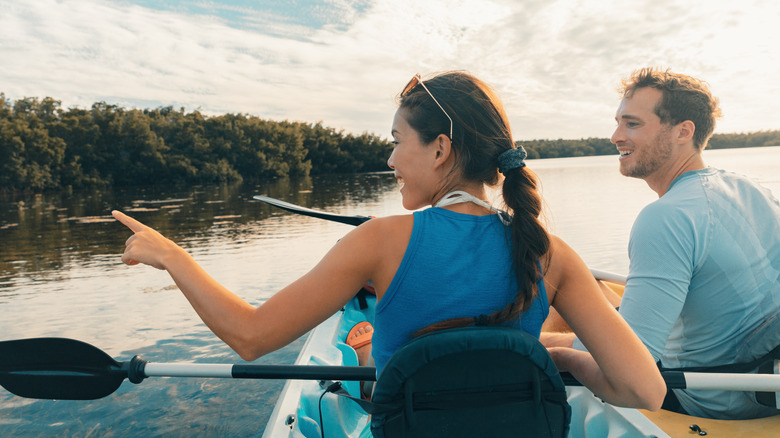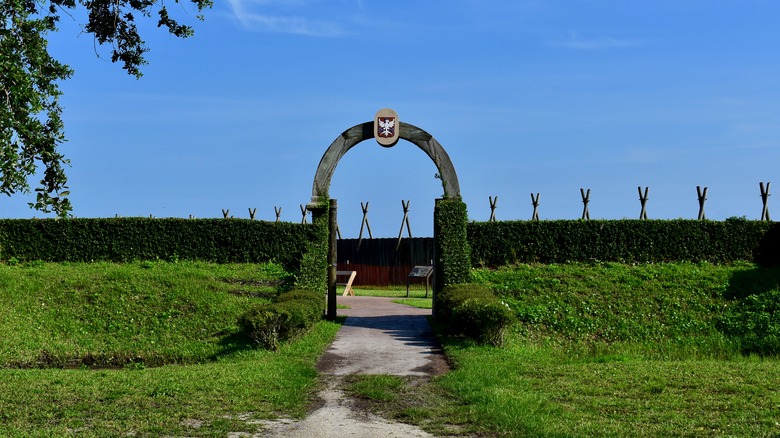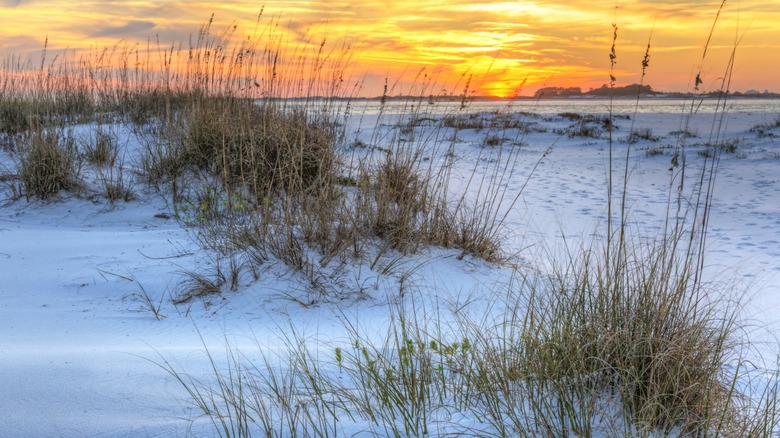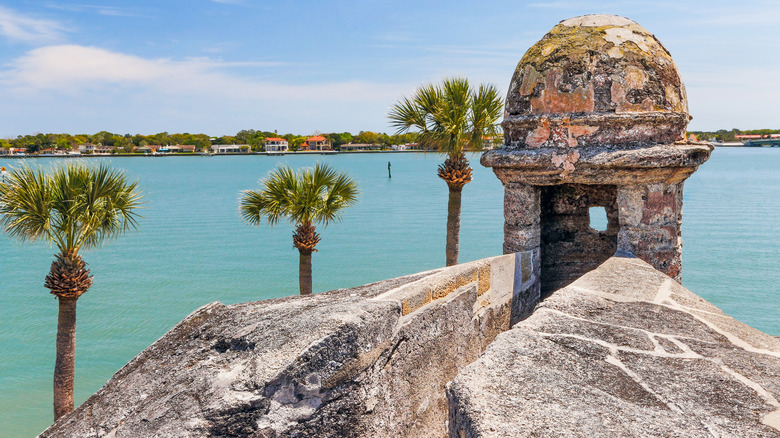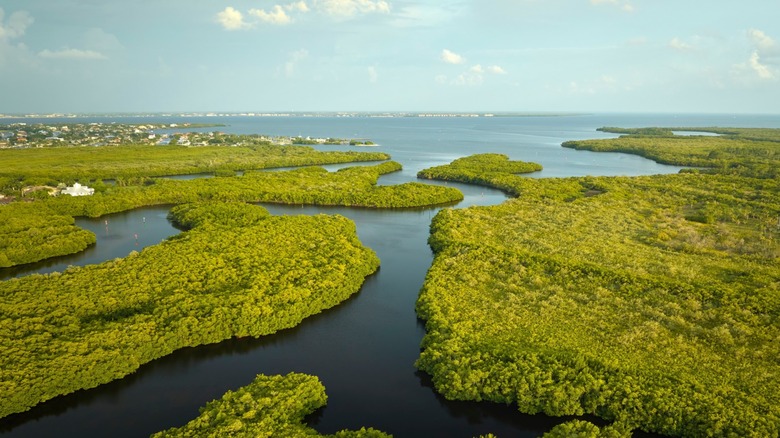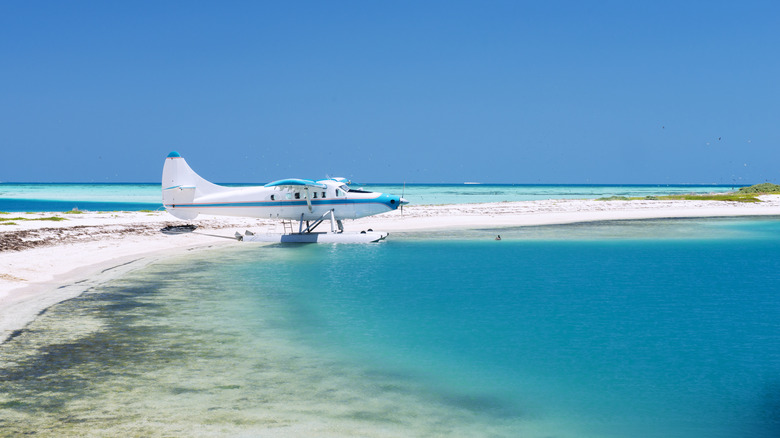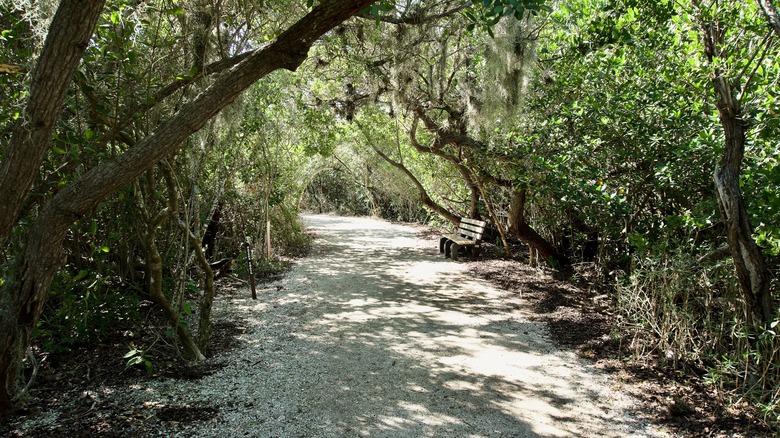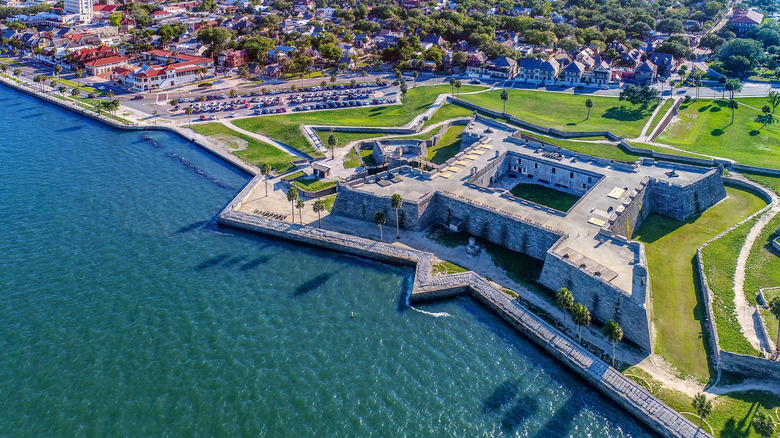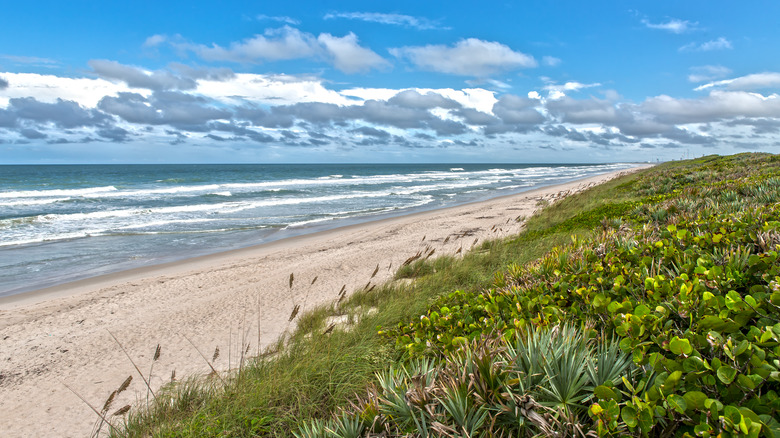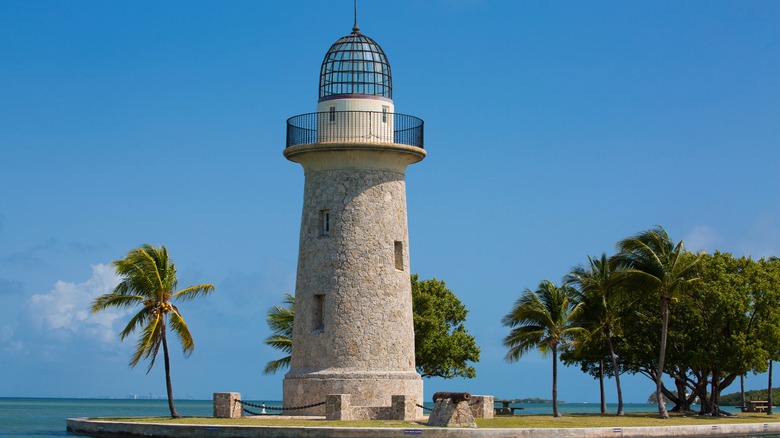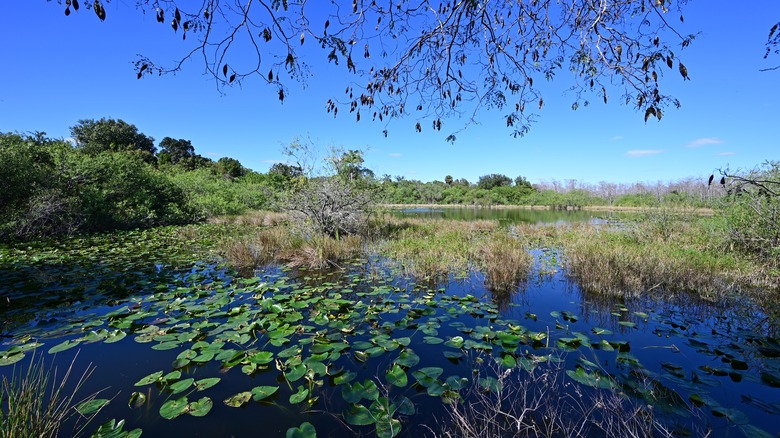The Best National Parks And Preserves To Add To Your Florida Bucket List
If you're in the market for some serious UV therapy on your next vacay, there are few better places to land than in the Sunshine State. From mouse-ear-fueled magic to Quidditch at Hogwarts, Florida serves up no shortage of theme park destination fun, and with its many miles of coastline and barrier islands, the peninsula state is a haven for beachgoers. But if you've had your fill of the tourist traps and you're looking for something a little off the beaten path, the contiguous United States' southernmost state is replete with hidden gems thanks to its natural diversity of ecosystems from dreamy estuaries to hidden keys. And the best part is that many of Florida's best destinations fall under the U.S. National Park Service, making each park, preserve, or monument an affordable, family-friendly spot for anyone's Florida bucket list.
Florida's national parks are some of the most beautiful in the country, and most are just a stone's throw from major cities or tourist attractions. From easily-accessible day trips to island camping excursions, be sure to check out this list of national parks to put on your Florida bucket list before your next trip to the Sunshine State.
Timucuan Ecological & Historic Preserve
If your Floridian vacay involves relaxing on Jacksonville's beaches, try to carve out some time to spend at the Timucuan Ecological & Historic Preserve. A lush landscape of waterways and wetlands, the area marks one of the earliest spots where disparate groups of European colonizers came into contact with each other and the Indigenous people who called the region home for millennia. Named for the Timucuan people who once inhabited the region, the preserve is an important archaeological site where visitors can learn about the region's past including the history, language, and culture of the Timucuan people. Learn about the lost colony of Fort Caroline and visit Kingsley Plantation — the state's oldest plantation — to honor the lives and experiences of the enslaved Africans who once struggled there.
If you enjoy nature watching, plan to spend a day kayaking or hiking through Timucuan's miles of trails. The vast ecosystem of Timucuan's salt marshes is home to foxes, bobcats, minks, armadillos, beavers, possums, bottlenose dolphins, and many more species. While there are no national park campgrounds located within the preserve, you can find plenty of state park camping within its boundaries.
Gulf Islands National Seashore
If your Florida plans include beachside vacationing, consider a trip to Gulf Islands National Seashore. Gulf Islands' stretch of seashore spans the Gulf of Mexico's northern coast from Florida to Mississippi and features barrier islands, bayous, and maritime forests. Home to a Civil War-era fort, the Fort Pickens area of the park offers several historic structures, a beach pavilion with tram stops and showers, a discovery center, the Battery Worth picnic area, and both RV and tent camping sites. If you enjoy exploring historic sites, you can also check out Fort Barrancas, the Navy Yard, and Advanced Redoubt, a 19th-century fort. Located near Fort Barrancas, you'll also find a system of trails and a visitors' center.
In the Naval Live Oaks area, you'll find more than 7 miles of trails and a picnic area overlooking the bay. If you're hoping to get a closer look at Gulf Islands' marine life, snorkeling and scuba are popular activities. Boating, fishing, and birdwatching are also popular activities for Gulf Islands visitors.
Fort Matanzas National Monument
Fort Matanzas National Monument encompasses a 300-acre coastal preserve located near Fort Matanzas, a fortified 18th-century Spanish colonial watchtower built to defend St. Augustine. Travel to the fort by ferry to learn about the hunter-gatherer Paleo-Indian people who lived there as far back as 12,000 years in the past. Learn about the 16th-century French colony that clashed with the Spanish crown and the bloody saga as the region changed hands between the French, the Spanish, and the English. To help bring history to life, the park often features 18th-century historical re-enactors who are more than happy to answer questions about colonial life and demonstrate what soldiers of the day would have carried in their backpacks. The park also offers historic weapon firing demonstrations occasionally.
Stroll around the barrier island and you'll see a wide range of habitats — salt marshes, dunes, maritime forests, and scrubs. Visit the canopy of the park's coastal hammock forest with its magnolias, live oaks, and cabbage palms. Take in the salt marsh at the estuary where freshwater meets the ocean and you'll see a host of crustaceans living in the tidal flats. Although they aren't allowed in the visitors' center, pets are welcome to visit the park with their owners as long as they're leashed and you clean up after them.
Everglades National Park
The jewel in Florida's crown, Everglades National Park is a sprawling tropical wetlands preserve located at Florida's southernmost tip. The 1.5-million-acre park is accessible via three entrances located across southern Florida and features four visitor centers. Located on the park's north side near Miami, the Shark Valley Visitor Center features an observation tower that's open 24 hours a day year-round and provides a 20-mile panoramic view of the Everglades. Nearby, you'll find 15 miles of paved road for bicycling or walking. Near the Gulf Coast Visitor Center, there's a kayak and canoe launch and concession boat tours.
Considered the Everglades' nucleus, Royal Palm near Homestead features trails and a historic missile site. Also in Homestead is the Guy Bradley Visitor Center at the Flamingo Bay entrance, where you'll find plenty of camping and hiking. The Everglades offers a wealth of activities including biking, canoeing, kayaking, birdwatching, boating, and fishing. For a closer look at the park, embark on the Park Employee for a Day geocache trail or ask about the park's ranger-led programs. Or for a more unique adventure, try slough slogging under the Everglades' cypress dome — a wet-footed Ranger-led hike through the wetlands that gets you up close and personal with nature.
Dry Tortugas National Park
If you're planning a trip to the Florida Keys, Dry Tortugas National Park offers something for everyone. Contrary to its arid name, only 1% of Dry Tortugas is actually made up of dry ground, which means that the Florida national park is almost completely under water. Connected to the world's third largest reef system, the park is a picturesque marine paradise of seven small islands discovered by Ponce de Leon as he searched for the fabled Fountain of Youth. Located 70 miles west of Key West, Dry Tortugas is only accessible by seaplane or boat. The park is home to Fort Jefferson, a 19th-century deepwater anchorage used to blockade Southern shipping during the Civil War. The park's swimming beaches and reefs make it perfect for snorkeling — just be careful as the currents can be strong and there are no lifeguards.
One of the best ways to get a closer look is by taking a swim around the moat wall. The fort also still features historic pilings that piers and coaling warehouses were once built upon to fuel U.S. Navy ships. While the piers and warehouses are long gone, the pilings that remain attract a variety of interesting marine wildlife including barracudas, sharks, tarpon, large grouper, and colorful coral. Snorkeling by night is also a popular activity as the fish are much more approachable after nightfall. Loggerhead Key, the Tortugas' largest island, features a historic lighthouse. The park also offers camping and is a beautiful spot for stargazers.
De Soto National Memorial
Tampa is one of Florida's most popular destinations for beachgoers, and just about an hour south in Bradenton you'll find one of the state's most treasured national monuments. Named for 16th-century conquistador Hernando de Soto, who landed in Tampa Bay in May 1539 in search of gold, De Soto National Memorial is another great spot to explore if you're interested in living history. One of the park's key attractions is Camp Uzita, a recreation of the Indigenous village de Soto encountered upon first arriving in the area that was later taken over by the Spaniards. Weather permitting, visitors to the camp can experience half-hour-long living history demonstrations. Here, guests can try on Spanish armor, explore Native huts, or interact with period-clad history re-enactors who are happy to demonstrate 16th-century weapons and blacksmithing and lend insight into Native cooking and craftsmanship. The park also offers kayak tours of the bay surrounding the village.
De Soto National Monument also provides a number of other ranger-led activities for guests including a fishing clinic, an archaeology-themed day camp called Raiders of the Lost Park, a coastal ecology camp, and a discovery camp that teaches kids how to use compasses and maps — an increasingly lost art in the era of GPS. Pets are welcome in De Soto if they follow certain guidelines, and the park even offers a BARK Ranger program dog owners can complete. Although the park also features several small beaches, the Cove Beach is your best bet due to fewer strong currents.
Castillo de San Marcos National Monument
Located on northeastern Florida's Atlantic coast, St. Augustine boasts an impressive record as the oldest European and African American settlement in the contiguous United States to be continuously inhabited. Castillo de San Marcos National Monument offers visitors the perfect day trip and a chance to explore St. Augustine's centuries of history. The centerpiece of the park is Castillo de San Marcos, a 17th-century masonry fort created in response to a devastating raid on St. Augustine. Located in Matanzas Bay on its western shore, the fort represents one of the best-preserved examples of a Spanish colonial masonry fort still in existence today.
Guests are invited to take a stroll through the fort's exhibits and casements, for which the park provides a self-guided audio tour accessible via smartphone. Located around the fort and along the seawall, the 18th-century and 19th-century artillery tour provides a glimpse at both cast iron and European bronze weapons. As they stroll around the fort, visitors can interact with period re-enactors who are happy to answer any questions or pose for photos with guests. The park also provides cannon and musket demonstrations throughout most weekends. If you're traveling with children, be sure to access the Castillo de San Marcos kids page before going, where you'll find coloring pages, science experiments, and more to help make your visit more educational and fun for everyone.
Canaveral National Seashore
If you're dreaming of a beach vacation, the Canaveral National Seashore offers everything you need for a complete getaway — and even better, there are spaceships. Florida's longest stretch of still-undeveloped Atlantic coastline, Canaveral is located on a barrier island that features miles of wetlands, dunes, hammocks, and pristine lagoon habitat.
Thanks to its estuaries and fertile natural landscape, the region has been inhabited on and off for more than 14,000 years. The park is home to the Turtle Mound Site, where generations of Timucuan people left large primarily oyster shell mounds from about 800 to 1400 CE to tell the story of their lives at Turtle Mound. Guests are invited to walk to the turtle shell-shaped site's 35-foot peak to take in a dazzling view of Florida's coast or stroll the fisherman's path around it to catch a glimpse of the subtropical and temperate flora and fauna that thrive there. Guests can also tour the Eldora State House, an original home dating back to the island's heyday as a winter resort around the turn of the 20th century.
One of Canaveral's biggest draws is the rare chance to explore a beach that's still free of hotels and tourist attractions. The park offers two beaches that are accessible by car and one accessible only by foot. Canaveral also features a couple of scenic drives, boat launches, and hiking and camping opportunities. And if you time your visit right, you can check out a rocket launch on Playalinda Beach.
Biscayne National Park
Upgraded from national monument to national park in 1980, Biscayne National Park can be found just a short drive south of Miami on Biscayne Bay. If your ideal vacation involves lots of clear blue water, Biscayne is the place you want to be. The 172,000-acre park is 95% water and home to dozens of small keys or islands — only three of them feature any kind of development.
The park's most popular island is Boca Chita Key. Here, guests can climb to the observation deck of the island's historic 65-foot ornamental lighthouse to get a view of the bay from the nearby islands to the Miami skyline in the distance. Visitors can also stop in for a picnic or dock at the island and camp overnight, although the key's close proximity to Miami and big boat-friendly harbor lends itself to a party atmosphere. Somewhat quieter, more family-friendly camping can be found on Biscayne's largest island, Elliot Key, and unlike Boca Chita, Elliot's camping includes showers for guests to use.
For guests who don't have their own boats, boat tours are available. Be sure to check out Stiltsville, a grouping of houses on stilts, located at the park's northern corner. Snorkeling is one of Biscayne's biggest draws, and there are plenty of great places to take in the reefs around the keys. If you plan to snorkel, be sure to check out the mangrove tree root system as it serves as a habitat for many types of fish. You can also explore the remains of famous shipwrecks underwater.
Big Cypress National Preserve
If you're hoping to catch a glimpse of some wildlife on your Floridian vacay, your best bet is Big Cypress National Park, a 729,000-acre cypress swampland that serves as home to both temperate and tropical plants including mangrove trees. Preservation efforts in the 1960s narrowly prevented this stunning natural resource from becoming the world's largest jetport, but fortunately, Native groups, conservationists, and other advocates were able to save the swamp, leading to its establishment as the first national preserve in the United States in 1974. As a preserve, the land is still in use by the Miccosukee and Seminole tribes, who still use timber to construct traditional chickee shelters and harvest animals and plants for personal use as their people have for many generations.
As a designated International Dark Sky Place, Big Cypress is an ideal destination for stargazing and offers a handful of astronomy programs for guests to participate in. The preserve also offers plenty of camping including backcountry camping available with permits. Guests can explore the preserve by hiking, using an off-road vehicle, or taking one of Big Cypress's two scenic drives. The preserve's robust wildlife population includes alligators, Florida black bears, softshell turtles, herons, egrets, and Florida's endangered panthers, just to name a few. It may surprise some visitors to see manatees swimming the canal behind the Reed Visitor Center — the adorable mammals can be viewed from a boardwalk observation spot. Fishing and hunting are available in the park in accordance with local regulations.
